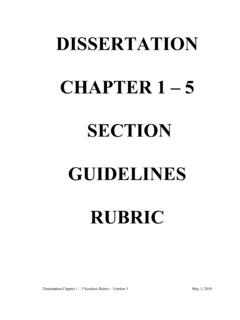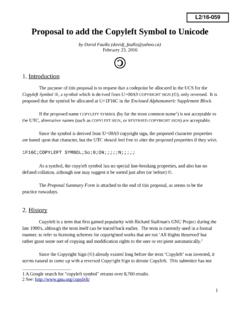Transcription of Guide for the Assessment of Project Proposals
1 EUROPEAN COMMISSION. JOINT RELEX SERVICE FOR THE MANAGEMENT OF COMMUNITY AID TO NON-MEMBER. COUNTRIES (SCR). Resources, relations with the other institutions, evaluation, and information Evaluation PCM Helpdesk Guide for the Assessment of Project Proposals Programming Evaluation Identification Implementation Formulation Financing This document has been produced by the PCM Helpdesk and is used as resource material in the PCM training programme. It is not an offical document, and remains in draft form. Guide to Assessment July 1999. PCM Basic Course Guide to the Assessment of Project Proposals Guide for the Assessment of Project Proposals Training and Helpdesk Services in Project Cycle Management Table of Contents Introduction to the 1. Instruction 1: Analysis of the Project 's Relevance (Part 1).. 2. Step 1: Read the Project proposal .
2 2. Step 2: Identify the beneficiaries and parties involved .. 2. Step 3: Identify the problems to be addressed .. 2. Step 4: Build a problem 2. Step 5: Identify the objectives of the Project .. 2. Step 6: Build an objective 2. Step 7: Analyse the relationships between stakeholders, problem tree and objective 2. Step 8: Formulate questions on the stakeholders, problem tree and objective tree .. 2. Instruction 2: Analysis of the Project 's Relevance (Part 2).. 3. Step 1: Prepare the Intervention Logic for the 3. Step 2: Analyse the extent to which the Project responds to identified problems and 3. Step 3: Formulate questions on the extent to which the proposed intervention responds to identified problems and 4. Instruction 3: Analysis of the Project 's Feasibility (Part 1) .. 5. Step 1: Identify the external 5. Step 2: Assess external factors to be included in the logframe as assumptions.
3 5. Step 3: Finalise the key assumptions to be included in the logframe .. 6. Step 4: Analyse the logframe on completeness and 6. Step 5: Formulate questions on the Project 's feasibility .. 6. Instruction 4: Analysis of the Project 's 7. Step 1: Identify which activities and results will have to continue beyond the life of the 7. Step 2: Check the Results and Activities to be continued against the sustainability 7. Step 3: Formulate questions regarding each factor for 8. Instruction 5: Analysis of the Project 's Feasibility (Part 2) .. 9. Step 1: Identify indicators and sources of verification for performance 9. Step 2: Identify sources of verification for the indicators .. 9. Step 3: Analyse the proposed performance measurement system for the 9. Step 4: Formulate questions regarding the performance measurement system .. 10. Instruction 6: Preparation of Terms of Reference for the Feasibility Study.
4 11. Step 1: Sort questions of Relevance, Feasibility and Sustainability .. 11. Step 2: Draft the Terms of Reference .. 11. Appendix 1: Preparing Problem and Objective 12. Guide to Assessment July 1999. PCM Basic Course Guide to the Assessment of Project Proposals Introduction to the Guide The Guide to Assessment is a tool to assist you in analysing new Project Proposals for which a feasibility study (or appraisal mission) is envisaged. New Project Proposals are received from a variety of sources (partner governments, NGOs, private sector organisations, etc.) and may be presented in a format very different from those used within the Commission. In particular, the proposal may not have an accompanying logframe. This Guide therefore has a dual purpose: To process the information in the proposal in order to prepare a draft logframe for the Project in other words, to convert the proposal to logframe format.
5 If a logframe already exists, it facilitates the validation of this logframe against PCM principles. To use the Logical Framework Approach to deconstruct and reconstruct the Project 's design in order to identify information gaps concerning the relevance, feasibility and sustainability of the Project . The Guide provides step-by-step instructions to the preparation of problem and objective trees, and a logframe. As they are developed, the Guide explains how these outputs should be analysed to determine: The adequacy of the target group description and problem analysis The relationship between stakeholders, identified problems, and the proposed intervention The completeness and coherence of Project objectives, and the adequacy of assumptions The extent to which mechanisms to build sustainability have been incorporated into the Project 's design The adequacy of the proposed performance measurement system The outcome of this analysis is likely to be a series of questions for which the proposal does not adequately provide answers.
6 However, the Guide is not a tool for knocking down' new Proposals ; rather it is intended as a means of determing what information should be collected prior to and during the Feasibility Study, in order that the Project is comprehensively researched and well-prepared. The output of this Assessment process is therefore a set of questions concerning the Project 's Relevance, Feasibility and Sustainability. These questions should then be incorporated into the Terms of Reference for the Feasibility Study. A simple example of a Project for SME support is used to illustrate the expected outputs for each instruction. The key concepts of Relevance, Feasibility and Sustainability can be explained as follows: Relevance relates to the importance of the problems to be addressed by the Project , and starts with determining for whom the Project is relevant.
7 At the Project purpose level, the Project should address the specific problems of the target group (for example, declining revenues of smallscale agricultural producers). At the overall objectives level the Project should address the related but wider problems of society as a whole (for example, declining standards of living in rural areas). Feasibility relates to whether the Project objectives can be effectively achieved. This requires an Assessment of the coherence of the Project 's intervention logic and assumptions ( if results are delivered, and assumptions hold true, will the proje ct purpose be achieved?) and of the capability of the implementing agency to mobilise the necessary resources and expertise to undertake Project activities within the time required. Sustainability relates to whether Project benefits will continue to flow after the period of external assistance has ended.
8 Although actual sustainability cannot be assessed ex ante, prospects for sustainability can be assessed by determining the extent to which mechanisms have been incorporated into Project design to address the key factors which have influenced sustainability in the past. Guide to Assessment 1. July 1999. PCM Basic Course Guide to the Assessment of Project Proposals Instruction 1: Analysis of the Project 's Relevance (Part 1). Instruction 1 is the first test of the relevance of the Project to the needs of the stated target group. The focus is therefore on identifying the target group, and assessing whether they and their problems are sufficiently described and analysed. Step 1: Read the Project proposal Step 2: Identify the beneficiaries and parties involved Mark all of the stakeholder groups mentioned in the proposal , and summarise each group on blue cards.
9 Identify the following groups: the target group (those who will benefit directly from the Project ). the final beneficiaries (if different from the above). the implementing agency Step 3: Identify the problems to be addressed Mark all of the problems mentioned in the proposal with a yellow text marker and write these on yellow cards. There should be one problem per card. Step 4: Build a problem tree Using the problem cards prepared in the previous step, develop a problem tree. For further instructions on this step, refer to appendix 1. Step 5: Identify the objectives of the Project Mark all of the objectives mentioned in the proposal with a green text marker and write these on green cards. There should be one objective per card. Step 6: Build an objective tree Using the objective cards prepared in the previous step, develop an objective tree.
10 For further instructions on this step, refer to appendix 1. Step 7: Analyse the relationships between stakeholders, problem tree and objective tree Use the following as Guide questions, but draw on your own knowledge and experience as well: Has the target group been clearly identified and described, with a gender breakdown if necessary? Have the problems of other stakeholders important to the Project 's success been identified? Does the problem analysis describe problems of the target group, or is it only of a general nature? Does the problem analysis have major gaps? Are the causal relationships between problems sufficiently explained? Are all of the problems addressed by objectives? Which problems are not addressed? Do all of the objectives have an underlying problem? Which objectives are not justified? Step 8: Formulate questions on the stakeholders, problem tree and objective tree These questions should be clarified by the Delegation or proposing organisation, or appear in the Terms of Reference for the Feasibility Study Illustration of expected outputs.







